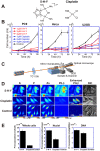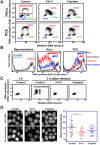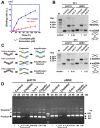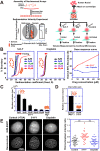Chromatin folding and DNA replication inhibition mediated by a highly antitumor-active tetrazolato-bridged dinuclear platinum(II) complex
- PMID: 27094881
- PMCID: PMC4837362
- DOI: 10.1038/srep24712
Chromatin folding and DNA replication inhibition mediated by a highly antitumor-active tetrazolato-bridged dinuclear platinum(II) complex
Abstract
Chromatin DNA must be read out for various cellular functions, and copied for the next cell division. These processes are targets of many anticancer agents. Platinum-based drugs, such as cisplatin, have been used extensively in cancer chemotherapy. The drug-DNA interaction causes DNA crosslinks and subsequent cytotoxicity. Recently, it was reported that an azolato-bridged dinuclear platinum(II) complex, 5-H-Y, exhibits a different anticancer spectrum from cisplatin. Here, using an interdisciplinary approach, we reveal that the cytotoxic mechanism of 5-H-Y is distinct from that of cisplatin. 5-H-Y inhibits DNA replication and also RNA transcription, arresting cells in the S/G2 phase, and are effective against cisplatin-resistant cancer cells. Moreover, it causes much less DNA crosslinking than cisplatin, and induces chromatin folding. 5-H-Y will expand the clinical applications for the treatment of chemotherapy-insensitive cancers.
Figures






Similar articles
-
Specific Conformational Change in Giant DNA Caused by Anticancer Tetrazolato-Bridged Dinuclear Platinum(II) Complexes: Middle-Length Alkyl Substituents Exhibit Minimum Effect.Inorg Chem. 2017 Jan 17;56(2):802-811. doi: 10.1021/acs.inorgchem.6b02239. Epub 2017 Jan 3. Inorg Chem. 2017. PMID: 28045514
-
Highly efficient uptake into cisplatin-resistant cells and the isomerization upon coordinative DNA binding of anticancer tetrazolato-bridged dinuclear platinum(II) complexes.Metallomics. 2015 Nov;7(11):1488-96. doi: 10.1039/c5mt00174a. Epub 2015 Sep 22. Metallomics. 2015. PMID: 26393664
-
[Drug discovery research in in-vivo antitumor-active azolato-bridged dinuclear Pt(II) complexes].Yakugaku Zasshi. 2012;132(3):253-9. doi: 10.1248/yakushi.132.253. Yakugaku Zasshi. 2012. PMID: 22382827 Review. Japanese.
-
Synthesis of antitumor azolato-bridged dinuclear platinum(ii) complexes with in vivo antitumor efficacy and unique in vitro cytotoxicity profiles.Metallomics. 2013 May;5(5):461-8. doi: 10.1039/c3mt00040k. Epub 2013 Apr 23. Metallomics. 2013. PMID: 23608770
-
Cellular processing of platinum anticancer drugs.Nat Rev Drug Discov. 2005 Apr;4(4):307-20. doi: 10.1038/nrd1691. Nat Rev Drug Discov. 2005. PMID: 15789122 Review.
Cited by
-
Zinc and iron dynamics in human islet amyloid polypeptide-induced diabetes mouse model.Sci Rep. 2023 Mar 15;13(1):3484. doi: 10.1038/s41598-023-30498-y. Sci Rep. 2023. PMID: 36922503 Free PMC article.
-
Azolato-Bridged Dinuclear Platinum(II) Complexes Exhibit Androgen Receptor-Mediated Anti-Prostate Cancer Activity.Inorg Chem. 2024 Nov 4;63(44):20951-20963. doi: 10.1021/acs.inorgchem.4c01093. Epub 2024 Sep 11. Inorg Chem. 2024. PMID: 39258898 Free PMC article.
-
Why Concurrent CDDP and Radiotherapy Has Synergistic Antitumor Effects: A Review of In Vitro Experimental and Clinical-Based Studies.Int J Mol Sci. 2021 Mar 19;22(6):3140. doi: 10.3390/ijms22063140. Int J Mol Sci. 2021. PMID: 33808722 Free PMC article. Review.
-
The RIF1-long splice variant promotes G1 phase 53BP1 nuclear bodies to protect against replication stress.Elife. 2020 Nov 3;9:e58020. doi: 10.7554/eLife.58020. Elife. 2020. PMID: 33141022 Free PMC article.
-
Data on synthesis and structure-activity relationships of tetrazolato-bridged dinuclear platinum(II) complexes.Data Brief. 2021 Dec 10;40:107697. doi: 10.1016/j.dib.2021.107697. eCollection 2022 Feb. Data Brief. 2021. PMID: 34993284 Free PMC article.
References
-
- Watson J. D. et al. Molecular Biology of the Gene, 7/E. (Benjamin Cummings, 2013).
-
- Davey G. E. & Davey C. A. Chromatin - a new, old drug target? Chem Biol Drug Des 72, 165–170 (2008). - PubMed
-
- Rosenberg B. & VanCamp L. The successful regression of large solid sarcoma 180 tumors by platinum compounds. Cancer Res 30, 1799–1802 (1970). - PubMed
-
- Kociba R. J., Sleight S. D. & Rosenberg B. Inhibition of Dunning asc itic leukemia and Walker 256 carcinosarcoma with cis-diamminedichloroplatinum (NSC-119875). Cancer Chemother Rep 54, 325–328 (1970). - PubMed
-
- Mansy S., Rosenberg B. & Thomson A. J. Binding of cis- and trans-dichlorodiammineplatinum(II) to nucleosides. I. Location of the binding sites. J Am Chem Soc 95, 1633–1640 (1973). - PubMed
Publication types
MeSH terms
Substances
LinkOut - more resources
Full Text Sources
Other Literature Sources

